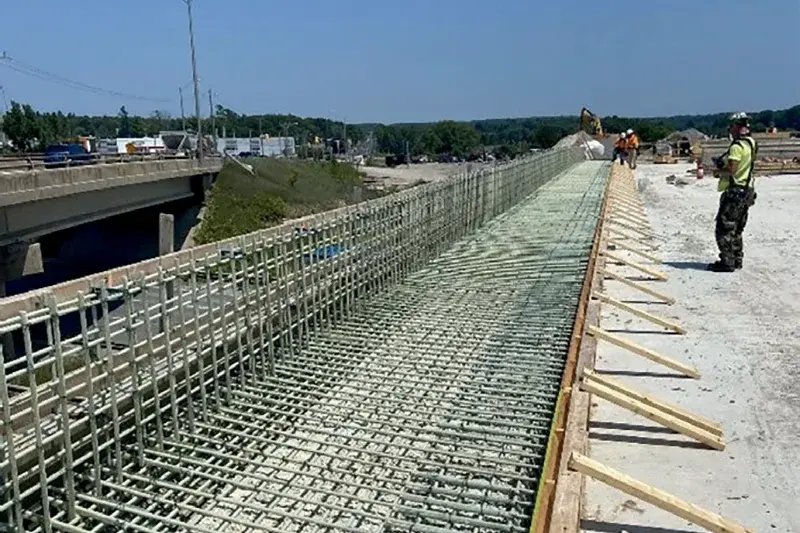2024 Preview: Three infrastructure trends for the year ahead
- Suncoast Reinforcing

- Feb 2, 2024
- 4 min read
Updated: May 15
From Construction Dive — By Julie Strupp —
The civil sector will confront a shifting regulatory landscape, burgeoning digitalization and evolving procurement norms in 2024.
With supply chains untangling, inflation cooling and the possibility of lower borrowing costs ahead, there’s a lot of positive signs for infrastructure in 2024.
The Infrastructure Investment and Jobs Act is more than two years into its five-year funding cycle, with a third of the money disbursed, and experts say its momentum is growing. The fruits of that funding are emerging and a wave of IIJA-funded projects are set to wrap up in 2024, especially in the roads and bridges sector.
Beyond dollars, Maria Lehman, vice chair of the President’s National Infrastructure Advisory Council and former president of the American Society of Civil Engineers, sees a more holistic, creative and collaborative approach taking hold in the industry.
“[The pandemic] has changed the propensity to fight change, because you have to deal with the deck you’re dealt with, and that means doing things differently and same-old, same-old isn’t going to do it,” Lehman said. “There’s a much bigger acceptance of that than there has been in the past.”
“At the very front end it would behoove contractors to really take a step back, really understand that source of funding, [and] understand those requirements,” said Flickinger. “Where the funds come from really drives what rules you have to comply with.”
More regulatory changes are also on the horizon: A proposed rule regarding Cybersecurity Maturity Model Certification, which conveys the Defense Department’s information security requirements for civilian contractors, will likely be finalized in 2024, said Flickinger.
That could bring new stipulations, including email encryption and restrictions on using equipment from certain countries. Progress is also expected on Buy Clean requirements, which aim to green the federal government’s procurement practices.
More digitalization in 2024
While infrastructure projects have used digital platforms for everything from drawings to document management for a while now, the complexity and capacity of those tools is rapidly expanding, said HKA Global Partner and civil engineer Caryn Fuller.
“Some of the challenges that we have are [whether or not we are] actually using these programs properly,” said Fuller. “It’s [important to make] sure that all people who are using these platforms are properly trained and know what platform they’re using.”
In other words, while tech can bolster productivity for builders, it’s not without challenges: Latecomers to a job may not get proper training on how to use a platform, and they “may not necessarily know the proper protocol and procedures,” Fuller said. Improper data entry could result in some members of a project not having access to the information they need.
Growing connectivity also opens up new kinds of risk: A slew of cyberattacks targeted critical infrastructure in the past year, hitting hardest the energy sector, which is subject to 39% of all critical infrastructure attacks. December ransomware hits on water and wastewater infrastructure highlighted the risk to those sectors, as well.
To help guard against cyber threats, civil contractors are subject to Controlled Unclassified Information policies, which are the feds’ constantly shifting requirements around information sharing and safeguarding.
“We’re seeing more bad player stressors than we have in the past,” said Lehman, and that requires hardening infrastructure and being careful with digital information sharing. “[Bad actors] are looking for the weak link, they’re not looking for Fort Knox.”
New procurement, delivery methods
The delivery methods for massive infrastructure projects are rapidly diversifying beyond the classic design-build and progressive design-build approaches, said Jill Kurth, AECOM’s Los Angeles Metro executive.
“[Increasingly, project teams are] bringing contractors directly into the dialogue, and [they are] talking about not only the delivery strategy, but about how to structure contracts to make it more efficient and effective for them to procure,” said Kurth.
For example, there are ways to bundle RFPs together to be able to bid projects at scale or to better share procurement risk with clients. At the same time, builders are getting engaged in the process much earlier, so there’s more collaboration, risk-sharing and transparency among the many actors involved in bringing a project to life.
While that’s generally viewed as a positive development in the industry, it also brings more complexity. For example, as contractors outsource procurement work, there’s a risk of communication breakdowns with subs and vendors over material quality or deadlines. At the same time, BABA and Buy Clean requirements add another challenge.
“The biggest risk from a supply chain standpoint is truly understanding where products are made,” said Flickinger. “The further you get away from anything that happens in your own company and your own business, the harder it is to make sure that you’re 100% compliant.”
Still, while supply chain vulnerability remains an issue, snarls are easing and industry pros are adapting to the new reality, according to Lehman.
Public and private clients alike are more often pre-purchasing the items that have long lead times — such as certain valves, traffic signal controllers and transformers — to avoid delaying a project, she said. That advance planning benefits suppliers as well as builders.
“We have too much to do and not enough people or resources to do it, so we have to deliver differently,” said Lehman. “That is exciting to me.”
CAPTION (above): The Brent Spence Bridge between Covington, Kentucky, and Cincinnati has gotten a financial boost from the federal Infrastructure Investment and Jobs Act. With the wave of new funding comes new regulations, experts said.
Reference
Strupp, J. (2024). The civil sector in 2024: Shifting regulations, digitalization, and procurement changes. Construction Dive. https://www.constructiondive.com/news/infrastructure-trends-legal-tech-procurement-2024/704652/
Suncoast Reinforcing is hiring!
If you’re looking for work, contact Suncoast Reinforcement for information about current openings.
We’re nearly always hiring skilled ironworkers, supervisors and helpers.




Comments